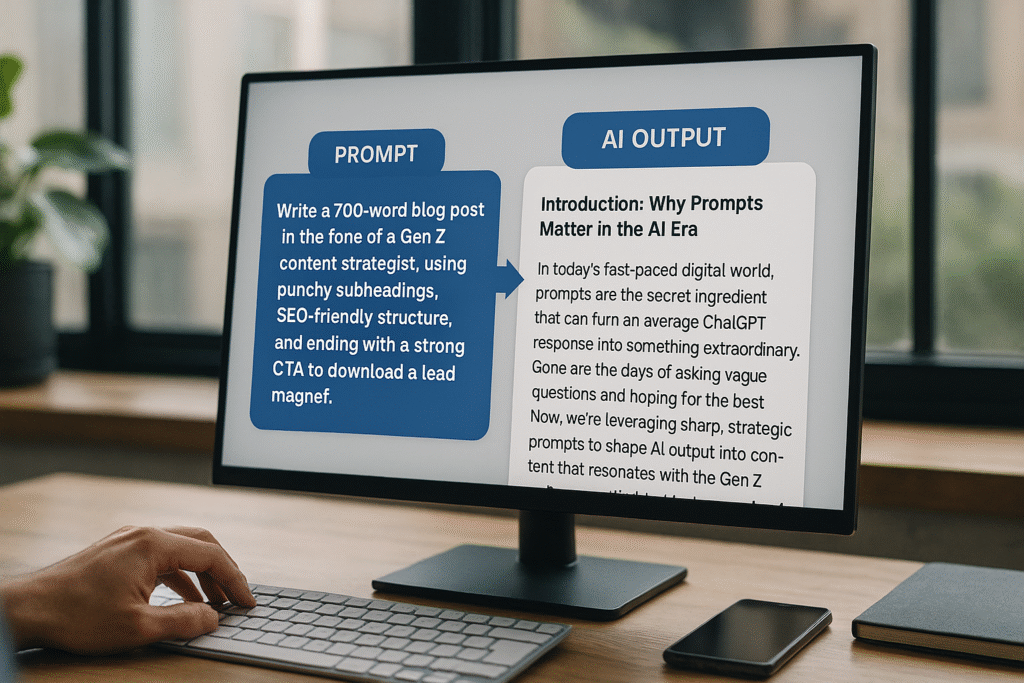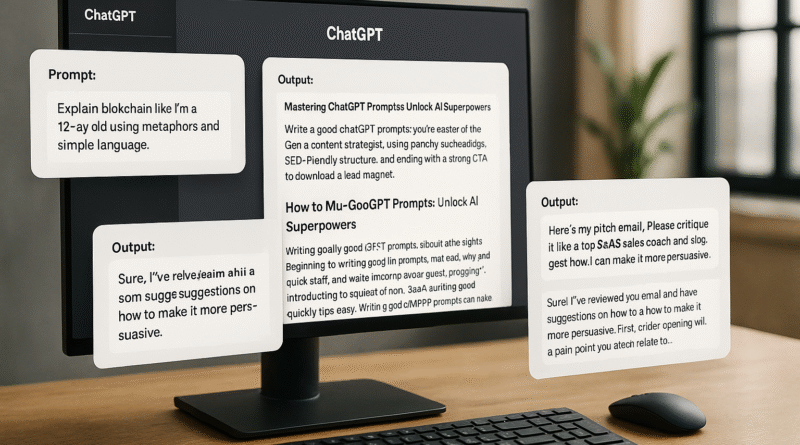5 Genius Prompts to Supercharge ChatGPT Output
Genius ChatGPT Prompts Introduction: Why Prompts Matter More Than You Think
Welcome to 2025, where ChatGPT isn’t just answering trivia or writing dad jokes anymore. It’s helping startups build investor pitch decks, marketers generate ad copy in seconds, students break down 60-page research papers, and content creators churn out scripts, captions, outlines, and more, all before lunch.
Already using ChatGPT? Here are 10 hacks that will save you hours.
But here’s what most people miss: ChatGPT is only as powerful as the prompt you give it.
Think of it like a Formula 1 car. Yes, the engine is incredibly fast. But if you don’t know how to steer, it won’t take you anywhere useful. A weak or vague prompt like “Write me a blog post” will likely return something generic, robotic, and uninspired, the kind of content that gets lost in the noise.
Now compare that with a prompt like:
“Write a 700-word blog post in the tone of a Gen Z content strategist, using punchy subheadings, SEO-friendly structure, and ending with a strong CTA to download a lead magnet.”
Suddenly, the output isn’t just better. It’s usable, on-brand, and often needs minimal editing. That’s the power of a well-crafted prompt, it doesn’t just help AI “work”; it helps it work for you.
This isn’t about hacking ChatGPT. It’s about learning to collaborate with it.
That’s why prompt crafting is quickly becoming a core skill across industries, not just for developers or engineers, but for:
- Freelancers and solopreneurs automating their content workflows
- Sales teams customizing outreach emails at scale
- Educators tailoring lesson plans
- Designers writing product descriptions or UX microcopy
- CEOs turning vision into internal memos and strategy docs
Whether you’re trying to write faster, think more clearly, or just get unstuck, a good prompt is like a flashlight in the fog, it shows the AI where to go, and gives you control over the direction.
In this article, I’ll break down 5 genius prompt formulas that I personally use and have taught to clients across sectors. These aren’t just fun tricks, they’re practical, repeatable, and adaptable to whatever you’re working on. You don’t need to be technical. You just need to know what you want, and how to say it clearly.
So whether you’re brand new to AI or someone who’s been “prompting” since GPT-3, this guide will help you unlock smarter, sharper, and more human-like results, with less time, less guessing, and a whole lot more creative control.
Let’s get into it.
Table of Contents
Why This Matters
AI is becoming an everyday co-pilot, but most people don’t know how to steer it. Learn how businesses are already using ChatGPT to scale communication and content workflows. The difference between a mediocre output and a game-changing one? A better prompt. As we move toward a world where prompt engineering becomes a core skill (just like Googling or emailing once did), learning how to shape your questions, context, and instructions is the ultimate productivity unlock.
These five genius prompts aren’t just hacks. They’re frameworks for thinking better, communicating clearly, and getting AI to meet you at your level of intention and creativity. Learn more about how ChatGPT processes instructions here.

Prompt #1: The Role + Goal Prompt
Format:
“You are a [role/expert/personality]. Your task is to [specific goal].”
Why it works: ChatGPT responds better when you define the persona it should adopt and the objective it should aim for. It reduces vagueness and increases task precision.
Example:
“You are a senior UX copywriter at Spotify. Your task is to write a playful but clear error message that appears when a song fails to load.”
When to use it:
- Crafting brand-specific copy
- Drafting emails, alerts, or onboarding flows
- Brainstorming creative writing or slogans
Prompt #2: The Step-by-Step Explainer
Format:
“Explain [concept] like I’m a [grade level/persona], step-by-step with examples.”
Why it works: This helps break down complexity with clarity. It also allows you to scale explanation depth, from kindergarten to PhD, depending on your audience. This is the same method used to explain complex mental health topics using AI.
Example:
“Explain blockchain like I’m a 12-year-old using metaphors and simple language.”
When to use it:
- Learning difficult concepts
- Creating training content
- Repackaging information for different audiences
Prompt #3: The Format-Specific Generator
Format:
“Write a [format] for [topic] that includes [specific elements].”
Why it works: This prompt gives ChatGPT structure, which it thrives on, while allowing creativity within clear constraints.
Example:
“Write a 90-second YouTube video script about the future of AI in education that includes a hook, 3 key points, and a CTA.”
When to use it:
- Generating video scripts, emails, ad copy
- Social content like tweets, threads, captions
- Repurposing long-form content into short-form
Prompt #4: The Rewrite with Style Prompt
Format:
“Rewrite this text in the style of [brand/personality], keeping the meaning but changing the tone.”
Why it works: You maintain your ideas but let ChatGPT transform the tone, voice, and emotional appeal, great for matching different brand personas or audiences.
Example:
“Rewrite this email in the style of Duolingo’s TikTok: snappy, cheeky, Gen Z-friendly.”
When to use it:
- Rewriting dry content into something more engaging
- Adapting messaging across audiences (e.g., C-suite vs consumers)
- A/B testing content tone
Prompt #5: The Critique & Improve Prompt
Format:
“Here’s my draft: [paste]. Please critique it like an expert [role] and suggest 3 improvements.”
Why it works: Instead of starting from scratch, you co-create and iterate. ChatGPT steps into an editorial role, helping polish, sharpen, and clarify.
Example:
“Here’s my pitch email. Please critique it like a top SaaS sales coach and suggest how I can make it more persuasive.”
When to use it:
- Reviewing your own writing before sending
- Improving landing page copy, resumes, pitches
- Turning decent drafts into polished assets
Bonus Prompt Tips: How to Get Even More Out of ChatGPT
- Use follow-ups: Don’t settle for the first draft. Ask, “Make it funnier,” “Add data,” or “Shorten it by 50 words.”
- Provide samples: Paste a paragraph and say, “Match this tone and structure.”
- Feed it your work: Use your previous content to teach ChatGPT your voice.
FAQ: Supercharging ChatGPT Prompts
Q1: Can beginners use these prompts?
Absolutely. These structures are easy to adapt, even if you’re just starting out with ChatGPT.
Q2: How do I make ChatGPT sound more like me?
Feed it samples of your writing and say, “Mimic this voice.” You can also use the “Rewrite with Style” prompt above.
Q3: Can these prompts be used in business or professional settings?
Yes. Many solopreneurs, marketers, recruiters, and salespeople use these formats to write faster and better.
Q4: What’s the difference between ChatGPT-3.5 and GPT-4 in prompt results?
GPT-4 tends to follow structured prompts more accurately, especially when creativity and tone are important.
Q5: Can I automate these prompts?
Yes, with tools like Zapier, Notion AI, or custom ChatGPT workflows, great for scaling content or workflows.
Final Thoughts: Don’t Just Prompt, Engineer
Prompts are no longer just casual questions, they’re strategic commands. As AI becomes a daily co-pilot, the ability to craft effective prompts will separate the mediocre from the magnetic.
The good news? You don’t have to be a prompt engineer to get great results. You just need the right structure, like the five genius prompts you now have at your fingertips.
Use them, test them, refine them, and you’ll unlock a smarter, faster, more creative version of yourself with a little help from a very capable AI.
